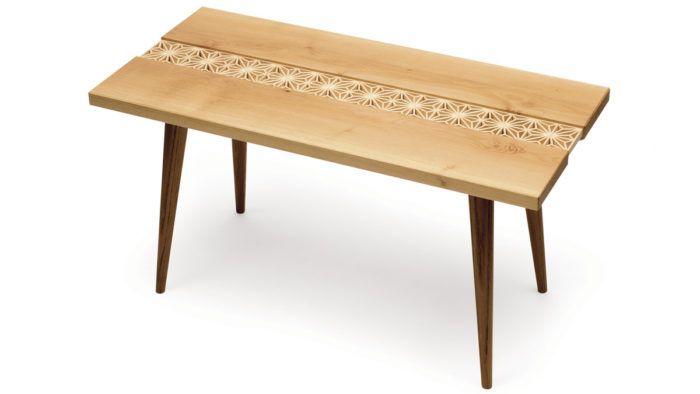Kumiko Coffee Table: The Story Behind the Design
A good lesson in less is more.

Synopsis: With the goal of using kumiko, or Japanese gridwork, in a new way, Jon Billing set out to design a coffee table with a kumiko top. But the initial design turned out to be too much of a good thing. His redesign, with a narrow strip of kumiko set into a solid surface, and a benchlike base, turned out to be a winner.
I’ve always been attracted to the quiet gridwork of shoji screens as well as to the delicate decorative patterns that often embellish them. wanting to use the potential of these patterns in a new way led me to think about how I could incorporate kumiko—the thin strips of wood within a shoji’s frame—in the surface of a table. My first attempt turned out to be a false start. For that table I envisioned essentially laying a shoji screen flat and sticking legs onto it. Since the only real structural part of a shoji screen is the surrounding frame, it was a challenge to find a way to attach the legs. My solution was to push the legs to the outside edges of the table. This plan never quite sat right with me, but I proceeded nonetheless, doing drawings both by hand and in SketchUp, and building a partial mockup. In the end, I decided that the table was too complex.
Mulling what I had learned from that initial design, I sat down to do some more sketches. I also started scouring through books looking for inspiration. In a book on Shaker furniture, I found a simple utility bench that really struck me. The bench had splayed legs attached to cleats, and the cleats were dadoed into a plank seat. I really liked the legs, which looked much more graceful and dynamic than the legs in my previous design. The simplicity of both the design and construction of the utility bench appealed to me.
Returning to SketchUp, I started to redesign the coffee table, incorporating ideas from the utility bench and toning down the kumiko pattern. I found that a single strip of kumiko down the center of the table reduced the busyness that I disliked in my original design and actually focused more attention on the pattern. It was a good lesson in less is more. Reducing the kumiko to a narrow strip also meant that I could use wide boards to make up the rest of the table surface, giving me more structure and better options for attaching the legs.
For the full article, download the PDF below:
Fine Woodworking Recommended Products

Drafting Tools

Dividers

Compass








Comments
Elegant, restful... love it!
Beautiful......really i like it
Log in or create an account to post a comment.
Sign up Log in